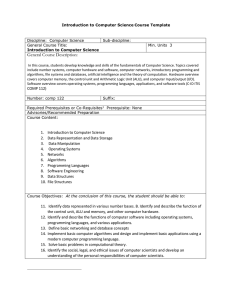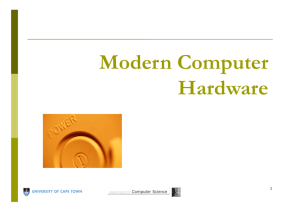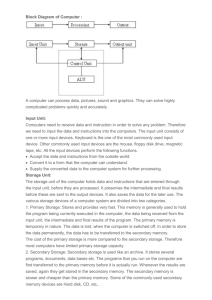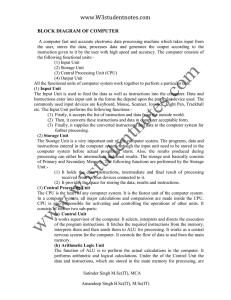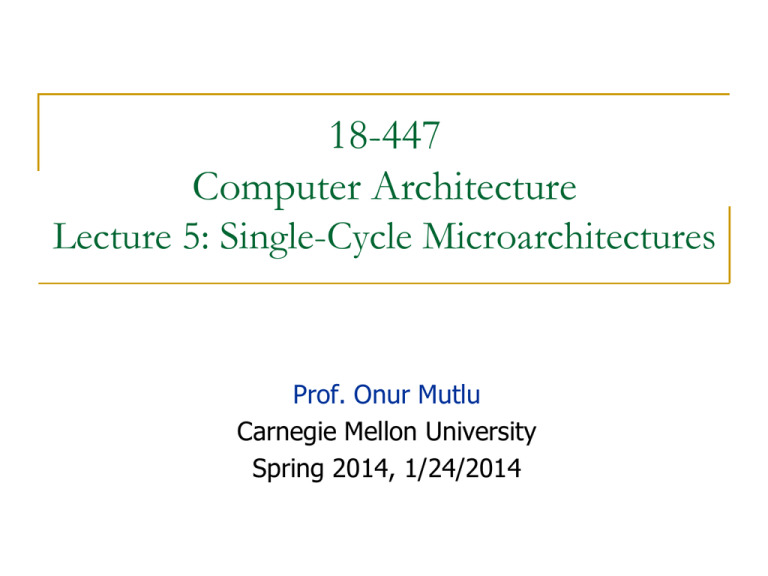
18-447
Computer Architecture
Lecture 5: Single-Cycle Microarchitectures
Prof. Onur Mutlu
Carnegie Mellon University
Spring 2014, 1/24/2014
Assignments
Lab 1 due today
Lab 2 out (start early)
HW1 due next week
HW0 issues
Make sure your forms are correctly filled in and readable
Extended deadline to resubmit: Sunday night (January 26)
2
A Single-Cycle Microarchitecture
A Closer Look
3
Remember…
Single-cycle machine
ASNext
Combinational
Logic
Sequential
Logic
(State)
AS
4
Let’s Start with the State Elements
Data and control inputs
on
5
Register
numbers
3
Read
register 1
5
Read
register 2
Registers
5 Write
Add Sum register
PC
Instruction
ion
ory
Data
Write
data
Read
data 1
Data
AL
Read
data 2
RegWrite
uction memory
b. Program counter
c. Adder
a. Registers
b
MemWrite
Instruction
address
Address
PC
Read
data
Instruction
Instruction
memory
a. Instruction memory
Add Sum
Write
data
b. Program counter
Data
memory
MemRead
a. Data memory unit
**Based on original figure from [P&H CO&D, COPYRIGHT 2004 Elsevier. ALL RIGHTS RESERVED.]
16
Sign
extend
c. Adder
b. Sign-exten
5
For Now, We Will Assume
“Magic” memory and register file
Combinational read
output of the read data port is a combinational function of the
register file contents and the corresponding read select port
Synchronous write
the selected register is updated on the positive edge clock
transition when write enable is asserted
Cannot affect read output in between clock edges
Single-cycle, synchronous memory
Contrast this with memory that tells when the data is ready
i.e., Ready bit: indicating the read or write is done
6
Instruction Processing
5 generic steps (P&H)
Instruction fetch (IF)
Instruction decode and register operand fetch (ID/RF)
Execute/Evaluate memory address (EX/AG)
Memory operand fetch (MEM)
Store/writeback result (WB)
WB
IF
Data
Register #
PC
Address
Instruction
memory
Instruction
Registers
ALU
Address
Register #
ID/RF
Register #
Data
memory
EX/AG
Data
**Based on original figure from [P&H CO&D, COPYRIGHT 2004 Elsevier. ALL RIGHTS RESERVED.]
MEM
7
What Is To Come: The Full MIPS Datapath
Instruction [25– 0]
26
Shift
left 2
PCSrc1=Jump
Jump address [31– 0]
28
PC+4 [31– 28]
ALU
Add result
Add
4
Instruction [31– 26]
Control
Instruction [25– 21]
PC
Read
address
Instruction
memory
Instruction [15– 11]
M
u
x
1
0
PCSrc2=Br Taken
Shift
left 2
RegDst
Jump
Branch
MemRead
MemtoReg
ALUOp
MemWrite
ALUSrc
RegWrite
0
M
u
x
1
Read
data 1
Read
register 2
Registers Read
Write
data 2
register
0
M
u
x
1
Write
data
Zero
bcond
ALU ALU
result
Address
Write
data
Instruction [15– 0]
1
M
u
x
Read
register 1
Instruction [20– 16]
Instruction
[31– 0]
0
16
Sign
extend
Read
data
Data
memory
1
M
u
x
0
32
ALU
control
ALU operation
Instruction [5– 0]
**Based on original figure from [P&H CO&D, COPYRIGHT 2004 Elsevier.
ALL RIGHTS RESERVED.]
JAL, JR, JALR omitted8
Single-Cycle Datapath for
Arithmetic and Logical Instructions
9
R-Type ALU Instructions
Assembly (e.g., register-register signed addition)
ADD rdreg rsreg rtreg
Machine encoding
0
rs
rt
rd
0
ADD
6-bit
5-bit
5-bit
5-bit
5-bit
6-bit
R-type
Semantics
if MEM[PC] == ADD rd rs rt
GPR[rd] GPR[rs] + GPR[rt]
PC PC + 4
10
ALU Datapath
Add
4
25:21
PC
Read
address
20:16
Instruction
Instruction
15:11
Instruction
memory
3
Read
register 1
Read
register 2
Registers
Write
register
Write
data
ALU operation
Read
data 1
Zero
ALU ALU
result
Read
data 2
RegWrite
1
IF
if MEM[PC] == ADD rd rs rt
GPR[rd] GPR[rs] + GPR[rt]
PCfrom
+ 4 2004 Elsevier. ALL RIGHTS RESERVED.]
**Based on original figure
[P&HPC
CO&D, COPYRIGHT
**Based on original figure from [P&H CO&D, COPYRIGHT 2004 Elsevier. ALL RIGHTS RESERVED.]
ID
EX
MEM WB
Combinational
state update logic
11
I-Type ALU Instructions
Assembly (e.g., register-immediate signed additions)
ADDI rtreg rsreg immediate16
Machine encoding
ADDI
rs
rt
immediate
6-bit
5-bit
5-bit
16-bit
I-type
Semantics
if MEM[PC] == ADDI rt rs immediate
GPR[rt] GPR[rs] + sign-extend (immediate)
PC PC + 4
12
Datapath for R and I-Type ALU Insts.
Add
4
PC
25:21
Read
address
20:16
Instruction
Instruction
Instruction
memory
15:11
RegDest
isItype
3
Read
register 1
Read
register 2
Registers
Write
register
Write
data
Zero
ALU ALU
result
GPR[rt] GPR[rs] + sign-extend (immediate)
PC PC + 4
**Based on original figure from [P&H CO&D, COPYRIGHT 2004 Elsevier. ALL RIGHTS RESERVED.]
Address
Read
data 2
Write
data
ALUSrc
Sign
extend
IF
if MEM[PC] == ADDI rt rs immediate
Mem
Read
data 1
RegWrite
116
ALU operation
32
Data
memo
isItype
ID
Mem
EX
MEM WB
Combinational
state update logic 13
Single-Cycle Datapath for
Data Movement Instructions
14
Load Instructions
Assembly (e.g., load 4-byte word)
LW rtreg offset16 (basereg)
Machine encoding
LW
base
rt
offset
6-bit
5-bit
5-bit
16-bit
I-type
Semantics
if MEM[PC]==LW rt offset16 (base)
EA = sign-extend(offset) + GPR[base]
GPR[rt] MEM[ translate(EA) ]
PC PC + 4
15
LW Datapath
Add
add
4
PC
Read
register 1
Read
address
Instruction
Instruction
Instruction
memory
Read
register 2
Registers
Write
register
Write
data
RegDest
isItype
3
MemWrite
Read
data 1
Zero
ALU ALU
result
Address
Address
Read
data 2
RegWrite
116
MemWrite
ALU operation
Write
data
ALUSrc
Sign
extend
if MEM[PC]==LW rt offset16 (base)
EA = sign-extend(offset) + GPR[base]
GPR[rt] MEM[ translate(EA) ]
PC PC + 4
32
Read
data
Read
data
16
Data
Write
data Data memory
memory
MemRead
isItype
MemRead
a. Data memory unit
IF
ID
EX
MEM WB
Combinational
state update logic 16
b. Si
Store Instructions
Assembly (e.g., store 4-byte word)
SW rtreg offset16 (basereg)
Machine encoding
SW
base
rt
offset
6-bit
5-bit
5-bit
16-bit
I-type
Semantics
if MEM[PC]==SW rt offset16 (base)
EA = sign-extend(offset) + GPR[base]
MEM[ translate(EA) ] GPR[rt]
PC PC + 4
17
SW Datapath
Add
add
4
PC
Read
register 1
Read
address
Instruction
Instruction
Instruction
memory
Read
register 2
Registers
Write
register
Write
data
RegDest
isItype
3
MemWrite
Read
data 1
Zero
ALU ALU
result
Address
Address
Read
data 2
Write
data
RegWrite
016
MemWrite
ALU operation
ALUSrc
Sign
extend
if MEM[PC]==SW rt offset16 (base)
EA = sign-extend(offset) + GPR[base]
MEM[ translate(EA) ] GPR[rt]
PC PC + 4
32
Read
data
Read
data
16
Data
Write
data Data memory
memory
MemRead
isItype
MemRead
a. Data memory unit
IF
ID
EX
MEM WB
Combinational
state update logic 18
b. Si
Load-Store Datapath
Add
4
PC
add
Read
register 1
Read
address
Instruction
Instruction
Instruction
memory
Read
register 2
Registers
Write
register
Write
data
RegDest
isItype
3
MemWrite
Read
data 1
Zero
ALU ALU
result
Read
data
Address
Read
data 2
RegWrite
!isStore
16
isStore
ALU operation
Sign
extend
32
ALUSrc
isItype
Write
data
Data
memory
MemRead
isLoad
**Based on original figure from [P&H CO&D, COPYRIGHT
2004 Elsevier. ALL RIGHTS RESERVED.]
19
Datapath for Non-Control-Flow Insts.
Add
4
PC
Read
register 1
Read
address
Instruction
Instruction
Instruction
memory
Read
register 2
Registers
Write
register
Write
data
RegDest
isItype
3
MemWrite
Read
data 1
Zero
ALU ALU
result
Read
data
Address
Read
data 2
RegWrite
!isStore
16
isStore
ALU operation
Sign
extend
32
ALUSrc
isItype
Write
data
Data
memory
MemRead
isLoad
MemtoReg
isLoad
**Based on original figure from [P&H CO&D, COPYRIGHT 2004 Elsevier. ALL RIGHTS RESERVED.]
20
Single-Cycle Datapath for
Control Flow Instructions
21
Unconditional Jump Instructions
Assembly
J immediate26
Machine encoding
J
immediate
6-bit
26-bit
J-type
Semantics
if MEM[PC]==J immediate26
target = { PC[31:28], immediate26, 2’b00 }
PC target
22
Unconditional Jump Datapath
isJ
Add
PCSrc
4
PC
Read
register 1
Read
address
Instruction
concat
Read
register 2
Registers
Write
register
Instruction
Instruction
memory
?
Write
data
3
XALU operation
MemWrite
Read
data 1
Zero
ALU ALU
result
**Based on original figure from [P&H CO&D, COPYRIGHT
2004 Elsevier. ALL RIGHTS RESERVED.]
if MEM[PC]==J immediate26
PC = { PC[31:28], immediate26, 2’b00 }
Read
data
Address
Read
data 2
RegWrite
0 16
0
Sign
extend
32
ALUSrc
X
Write
data
Data
memory
MemRead
0
23
What about JR, JAL, JALR?
Conditional Branch Instructions
Assembly (e.g., branch if equal)
BEQ rsreg rtreg immediate16
Machine encoding
BEQ
rs
rt
immediate
6-bit
5-bit
5-bit
16-bit
I-type
Semantics (assuming no branch delay slot)
if MEM[PC]==BEQ rs rt immediate16
target = PC + 4 + sign-extend(immediate) x 4
if GPR[rs]==GPR[rt] then PC target
else
PC PC + 4
24
Conditional Branch Datapath (For You to Fix)
watch out
PC + 4 from instruction datapath
Add
PCSrc
Add Sum
4
PC
Shift
left 2
Read
address
Instruction
concat
Instruction
memory
Instruction
Branch target
sub
ALU operation
3
Read
register 1
Read
register 2
Registers
Write
register
Write
data
Read
data 1
ALU bcond
Zero
To branch
control logic
Read
data 2
RegWrite
0
16
Sign
extend
32
**Based on original figure from [P&H CO&D, COPYRIGHT 2004 Elsevier. ALL RIGHTS RESERVED.]
25
How to uphold the delayed branch semantics?
Putting It All Together
Instruction [25– 0]
26
Shift
left 2
PCSrc1=Jump
Jump address [31– 0]
28
PC+4 [31– 28]
ALU
Add result
Add
4
Instruction [31– 26]
Control
Instruction [25– 21]
PC
Read
address
Instruction
memory
Instruction [15– 11]
M
u
x
1
0
PCSrc2=Br Taken
Shift
left 2
RegDst
Jump
Branch
MemRead
MemtoReg
ALUOp
MemWrite
ALUSrc
RegWrite
0
M
u
x
1
Read
data 1
Read
register 2
Registers Read
Write
data 2
register
0
M
u
x
1
Write
data
Zero
bcond
ALU ALU
result
Address
Write
data
Instruction [15– 0]
1
M
u
x
Read
register 1
Instruction [20– 16]
Instruction
[31– 0]
0
16
Sign
extend
Read
data
Data
memory
1
M
u
x
0
32
ALU
control
ALU operation
Instruction [5– 0]
**Based on original figure from [P&H CO&D, COPYRIGHT 2004 Elsevier.
ALL RIGHTS RESERVED.]
26
JAL, JR, JALR omitted
Single-Cycle Control Logic
27
Single-Cycle Hardwired Control
As combinational function of Inst=MEM[PC]
31
21
16
11
6
0
0
rs
rt
rd
shamt
funct
6-bit
5-bit
5-bit
5-bit
5-bit
6-bit
31
26
21
16
0
opcode
rs
rt
immediate
6-bit
5-bit
5-bit
16-bit
31
26
26
0
opcode
immediate
6-bit
26-bit
R-type
I-type
J-type
Consider
All R-type and I-type ALU instructions
LW and SW
BEQ, BNE, BLEZ, BGTZ
J, JR, JAL, JALR
28
Single-Bit Control Signals
When De-asserted
RegDest
ALUSrc
MemtoReg
RegWrite
When asserted
Equation
GPR write select
according to rt, i.e.,
inst[20:16]
GPR write select
according to rd, i.e.,
inst[15:11]
opcode==0
2nd ALU input from 2nd
GPR read port
2nd ALU input from sign- (opcode!=0) &&
extended 16-bit
(opcode!=BEQ) &&
immediate
(opcode!=BNE)
Steer ALU result to GPR
write port
steer memory load to
GPR wr. port
opcode==LW
GPR write disabled
GPR write enabled
(opcode!=SW) &&
(opcode!=Bxx) &&
(opcode!=J) &&
(opcode!=JR))
29
JAL and JALR require additional RegDest and MemtoReg options
Single-Bit Control Signals
When De-asserted
MemRead
MemWrite
Equation
Memory read disabled
Memory read port
return load value
opcode==LW
Memory write disabled
Memory write enabled
opcode==SW
According to PCSrc2
next PC is based on 26bit immediate jump
target
(opcode==J) ||
next PC is based on 16bit immediate branch
target
(opcode==Bxx) &&
PCSrc1
next PC = PC + 4
PCSrc2
When asserted
(opcode==JAL)
“bcond is satisfied”
30
JR and JALR require additional PCSrc options
ALU Control
case opcode
‘0’ select operation according to funct
‘ALUi’ selection operation according to opcode
‘LW’ select addition
‘SW’ select addition
‘Bxx’ select bcond generation function
__ don’t care
Example ALU operations
ADD, SUB, AND, OR, XOR, NOR, etc.
bcond on equal, not equal, LE zero, GT zero, etc.
31
R-Type ALU
Instruction [25– 0]
26
Shift
left 2
PCSrc1=Jump
Jump address [31– 0]
28
PC+4 [31– 28]
ALU
Add result
Add
4
Instruction [31– 26]
Control
Instruction [25– 21]
PC
Read
address
Read
register 1
Instruction [20– 16]
Instruction
[31– 0]
Instruction
memory
Instruction [15– 11]
RegDst
Jump
Branch
MemRead
MemtoReg
ALUOp
MemWrite
ALUSrc
RegWrite
0
M
u
x
1
1
M
u
x
M
u
x
1
0
PCSrc2=Br Taken
Shift
left 2
1
0
Read
data 1
Read
register 2
Registers Read
Write
data 2
register
0
M
u
x
1
Write
data
Zero
bcond
ALU ALU
result
16
Sign
extend
Read
data
Address
Write
data
Instruction [15– 0]
0
Data
memory
1
M
u
x
0
32
funct ALU operation
ALU
control
0
Instruction [5– 0]
**Based on original figure from [P&H CO&D, COPYRIGHT
2004 Elsevier. ALL RIGHTS RESERVED.]
32
I-Type ALU
Instruction [25– 0]
26
Shift
left 2
PCSrc1=Jump
Jump address [31– 0]
28
PC+4 [31– 28]
ALU
Add result
Add
4
Instruction [31– 26]
Control
Instruction [25– 21]
PC
Read
address
Instruction
memory
Read
register 1
Instruction [20– 16]
Instruction
[31– 0]
Instruction [15– 11]
RegDst
Jump
Branch
MemRead
MemtoReg
ALUOp
MemWrite
ALUSrc
RegWrite
0
M
u
x
1
1
M
u
x
M
u
x
1
0
PCSrc2=Br Taken
Shift
left 2
1
0
Read
data 1
Read
register 2
Registers Read
Write
data 2
register
0
M
u
x
1
Write
data
Zero
bcond
ALU ALU
result
16
Sign
extend
Read
data
Address
Write
data
Instruction [15– 0]
0
Data
memory
1
M
u
x
0
32
opcodeALU operation
ALU
control
0
Instruction [5– 0]
**Based on original figure from [P&H CO&D, COPYRIGHT 2004
Elsevier. ALL RIGHTS RESERVED.]
33
LW
Instruction [25– 0]
26
Shift
left 2
PCSrc1=Jump
Jump address [31– 0]
28
PC+4 [31– 28]
ALU
Add result
Add
4
Instruction [31– 26]
Control
Instruction [25– 21]
PC
Read
address
Instruction
memory
Read
register 1
Instruction [20– 16]
Instruction
[31– 0]
Instruction [15– 11]
RegDst
Jump
Branch
MemRead
MemtoReg
ALUOp
MemWrite
ALUSrc
RegWrite
0
M
u
x
1
1
M
u
x
M
u
x
1
0
PCSrc2=Br Taken
Shift
left 2
1
0
Read
data 1
Read
register 2
Registers Read
Write
data 2
register
0
M
u
x
1
Write
data
Zero
bcond
ALU ALU
result
16
Sign
extend
Read
data
Address
Write
data
Instruction [15– 0]
0
Data
memory
1
M
u
x
0
32
Add
ALU
control
ALU operation
1
Instruction [5– 0]
**Based on original figure from [P&H CO&D, COPYRIGHT 2004
Elsevier. ALL RIGHTS RESERVED.]
34
SW
Instruction [25– 0]
26
Shift
left 2
PCSrc1=Jump
Jump address [31– 0]
28
PC+4 [31– 28]
ALU
Add result
Add
4
Instruction [31– 26]
Control
Instruction [25– 21]
PC
Read
address
Instruction
memory
Read
register 1
Instruction [20– 16]
Instruction
[31– 0]
Instruction [15– 11]
RegDst
Jump
Branch
MemRead
MemtoReg
ALUOp
MemWrite
ALUSrc
RegWrite
0
M
u
x
1
*
1
M
u
x
M
u
x
1
0
PCSrc2=Br Taken
Shift
left 2
0
1
Read
data 1
Read
register 2
Registers Read
Write
data 2
register
0
M
u
x
1
Write
data
Zero
bcond
ALU ALU
result
16
Sign
extend
Read
data
Address
Write
data
Instruction [15– 0]
0
Data
memory
1
M
u
x
0
*
32
Add
ALU
control
ALU operation
0
Instruction [5– 0]
**Based on original figure from [P&H CO&D, COPYRIGHT 2004
Elsevier. ALL RIGHTS RESERVED.]
35
Branch Not Taken
Some control signals are dependent
on the processing of data
Instruction [25– 0]
26
Shift
left 2
PCSrc1=Jump
Jump address [31– 0]
28
PC+4 [31– 28]
ALU
Add result
Add
4
Instruction [31– 26]
Control
Instruction [25– 21]
PC
Read
address
Instruction
memory
Read
register 1
Instruction [20– 16]
Instruction
[31– 0]
Instruction [15– 11]
Instruction [15– 0]
RegDst
Jump
Branch
MemRead
MemtoReg
ALUOp
MemWrite
ALUSrc
RegWrite
0
M
u
x
1
*
0
1
M
u
x
M
u
x
1
0
PCSrc2=Br Taken
Shift
left 2
0
0
Read
data 1
Read
register 2
Registers Read
Write
data 2
register
0
M
u
x
1
Write
data
Zero
bcond
ALU ALU
result
Write
data
16
Sign
extend
Read
data
Address
Data
memory
1
M
u
x
0
*
32
bcondALU operation
ALU
control
0
Instruction [5– 0]
**Based on original figure from [P&H CO&D, COPYRIGHT 2004
Elsevier. ALL RIGHTS RESERVED.]
36
Branch Taken
Some control signals are dependent
on the processing of data
Instruction [25– 0]
26
Shift
left 2
PCSrc1=Jump
Jump address [31– 0]
28
PC+4 [31– 28]
ALU
Add result
Add
4
Instruction [31– 26]
Control
Instruction [25– 21]
PC
Read
address
Read
register 1
Instruction [20– 16]
Instruction
[31– 0]
Instruction
memory
Instruction [15– 11]
Instruction [15– 0]
RegDst
Jump
Branch
MemRead
MemtoReg
ALUOp
MemWrite
ALUSrc
RegWrite
0
M
u
x
1
*
0
1
M
u
x
M
u
x
1
0
PCSrc2=Br Taken
Shift
left 2
0
0
Read
data 1
Read
register 2
Registers Read
Write
data 2
register
0
M
u
x
1
Write
data
Zero
bcond
ALU ALU
result
Write
data
16
Sign
extend
Read
data
Address
Data
memory
1
M
u
x
0
*
32
bcondALU operation
ALU
control
0
Instruction [5– 0]
**Based on original figure from [P&H CO&D, COPYRIGHT
2004 Elsevier. ALL RIGHTS RESERVED.]
37
Jump
Instruction [25– 0]
26
Shift
left 2
PCSrc1=Jump
Jump address [31– 0]
28
PC+4 [31– 28]
4
Instruction [31– 26]
Control
Instruction [25– 21]
PC
Read
address
Read
register 1
Instruction [20– 16]
Instruction
[31– 0]
Instruction
memory
Instruction [15– 11]
Instruction [15– 0]
RegDst
Jump
Branch
MemRead
MemtoReg
ALUOp
MemWrite
ALUSrc
RegWrite
0
M
u
x
1
*
M
u
x
M
u
x
1
0
PCSrc2=Br Taken
Shift
left 2
0
0
Read
data 1
Read
register 2
Registers Read
Write
data 2
register
0
M
u
x
1
*
Write
data
16
Instruction [5– 0]
**Based on original figure from [P&H CO&D, COPYRIGHT
2004 Elsevier. ALL RIGHTS RESERVED.]
1
*
ALU
Add result
Add
0
Sign
extend
Zero
bcond
ALU ALU
result
Read
data
Address
Write
data
Data
memory
1
M
u
x
0
*
32
*
ALU
control
ALU operation
0
38
What is in That Control Box?
Combinational Logic Hardwired Control
Idea: Control signals generated combinationally based on
instruction
Necessary in a single-cycle microarchitecture…
Sequential Logic Sequential/Microprogrammed Control
Idea: A memory structure contains the control signals
associated with an instruction
Control Store
39
Evaluating the Single-Cycle
Microarchitecture
40
A Single-Cycle Microarchitecture
Is this a good idea/design?
When is this a good design?
When is this a bad design?
How can we design a better microarchitecture?
41
A Single-Cycle Microarchitecture: Analysis
Every instruction takes 1 cycle to execute
How long each instruction takes is determined by how long
the slowest instruction takes to execute
CPI (Cycles per instruction) is strictly 1
Even though many instructions do not need that long to
execute
Clock cycle time of the microarchitecture is determined by
how long it takes to complete the slowest instruction
Critical path of the design is determined by the processing
time of the slowest instruction
42
What is the Slowest Instruction to Process?
Let’s go back to the basics
All six phases of the instruction processing cycle take a single
machine clock cycle to complete
Fetch
1. Instruction fetch (IF)
Decode
2. Instruction decode and
register operand fetch (ID/RF)
Evaluate Address
3. Execute/Evaluate memory address (EX/AG)
Fetch Operands
4. Memory operand fetch (MEM)
Execute
5. Store/writeback result (WB)
Store Result
Do each of the above phases take the same time (latency)
for all instructions?
43
Single-Cycle Datapath Analysis
Assume
memory units (read or write): 200 ps
ALU and adders: 100 ps
register file (read or write): 50 ps
other combinational logic: 0 ps
steps
IF
ID
EX
MEM
mem
WB
RF
Delay
resources
mem
RF
ALU
R-type
200
50
100
50
400
I-type
200
50
100
50
400
LW
200
50
100
200
50
600
SW
200
50
100
200
Branch
200
50
100
Jump
200
550
350
200
44
Let’s Find the Critical Path
Instruction [25– 0]
26
Shift
left 2
PCSrc1=Jump
Jump address [31– 0]
28
PC+4 [31– 28]
ALU
Add result
Add
4
Instruction [31– 26]
Control
Instruction [25– 21]
PC
Read
address
Instruction
memory
Instruction [15– 11]
M
u
x
M
u
x
1
0
PCSrc2=Br Taken
Shift
left 2
RegDst
Jump
Branch
MemRead
MemtoReg
ALUOp
MemWrite
ALUSrc
RegWrite
0
M
u
x
1
Read
data 1
Read
register 2
Registers Read
Write
data 2
register
0
M
u
x
1
Write
data
Zero
bcond
ALU ALU
result
Address
Write
data
Instruction [15– 0]
1
Read
register 1
Instruction [20– 16]
Instruction
[31– 0]
0
16
Sign
extend
Read
data
Data
memory
1
M
u
x
0
32
ALU
control
ALU operation
Instruction [5– 0]
[Based on original figure from P&H CO&D, COPYRIGHT 2004
Elsevier. ALL RIGHTS RESERVED.]
45
R-Type and I-Type ALU
Instruction [25– 0]
26
Shift
left 2
PCSrc1=Jump
Jump address [31– 0]
28
PC+4 [31– 28]
Add
ALU
Add result
100ps
4
Instruction [31– 26]
Control
100ps
Instruction [25– 21]
PC
Read
address
200ps
Instruction
memory
Instruction [15– 11]
M
u
x
M
u
x
1
0
PCSrc2=Br Taken
Shift
left 2
RegDst
Jump
Branch
MemRead
MemtoReg
ALUOp
MemWrite
ALUSrc
RegWrite
0
M
u
x
1
Read
data 1
Read
register 2
Registers Read
Write
data 2
register
Write
data
250ps
400ps
0
M
u
x
1
Zero
bcond
ALU ALU
result
Address
350ps
Write
data
Instruction [15– 0]
1
Read
register 1
Instruction [20– 16]
Instruction
[31– 0]
0
16
Sign
extend
Read
data
Data
memory
1
M
u
x
0
32
ALU
control
ALU operation
Instruction [5– 0]
[Based on original figure from P&H CO&D, COPYRIGHT
2004 Elsevier. ALL RIGHTS RESERVED.]
46
LW
Instruction [25– 0]
26
Shift
left 2
PCSrc1=Jump
Jump address [31– 0]
28
PC+4 [31– 28]
Add
ALU
Add result
100ps
4
Instruction [31– 26]
Control
100ps
Instruction [25– 21]
PC
Read
address
200ps
Instruction
memory
Instruction [15– 11]
Instruction [15– 0]
1
M
u
x
M
u
x
1
0
PCSrc2=Br Taken
Shift
left 2
RegDst
Jump
Branch
MemRead
MemtoReg
ALUOp
MemWrite
ALUSrc
RegWrite
Read
register 1
Instruction [20– 16]
Instruction
[31– 0]
0
0
M
u
x
1
Read
data 1
Read
register 2
Registers Read
Write
data 2
register
250ps
0
M
u
x
1
Write
data
600ps
16
Zero
bcond
ALU ALU
result
Address
350ps
Write
data
Sign
extend
Read
data
Data
memory
550ps
1
M
u
x
0
32
ALU
control
ALU operation
Instruction [5– 0]
[Based on original figure from P&H CO&D, COPYRIGHT
2004 Elsevier. ALL RIGHTS RESERVED.]
47
SW
Instruction [25– 0]
26
Shift
left 2
PCSrc1=Jump
Jump address [31– 0]
28
PC+4 [31– 28]
Add
ALU
Add result
100ps
4
Instruction [31– 26]
Control
100ps
Instruction [25– 21]
PC
Read
address
200ps
Instruction
memory
Instruction [15– 11]
M
u
x
M
u
x
1
0
PCSrc2=Br Taken
Shift
left 2
RegDst
Jump
Branch
MemRead
MemtoReg
ALUOp
MemWrite
ALUSrc
RegWrite
0
M
u
x
1
Read
data 1
Read
register 2
Registers Read
Write
data 2
register
250ps
0
M
u
x
1
Write
data
Zero
bcond
ALU ALU
result
Address
16
Sign
extend
Read
data
350ps 550ps
Write
data
Instruction [15– 0]
1
Read
register 1
Instruction [20– 16]
Instruction
[31– 0]
0
Data
memory
1
M
u
x
0
32
ALU
control
ALU operation
Instruction [5– 0]
[Based on original figure from P&H CO&D, COPYRIGHT
2004 Elsevier. ALL RIGHTS RESERVED.]
48
Branch Taken
Instruction [25– 0]
26
Shift
left 2
PCSrc1=Jump
Jump address [31– 0]
28
200ps
PC+4 [31– 28]
100ps
ALU
Add result
Add
4
Instruction [31– 26]
Control
350ps
Instruction [25– 21]
PC
Read
address
200ps
Instruction
memory
Instruction [15– 11]
0
M
u
x
1
M
u
x
M
u
x
1
0
PCSrc2=Br Taken
Read
data 1
Read
register 2
Registers Read
Write
data 2
register
350ps
250ps
0
M
u
x
1
Write
data
Zero
bcond
ALU ALU
result
Address
Write
data
Instruction [15– 0]
1
Shift
left 2
RegDst
Jump
Branch
MemRead
MemtoReg
ALUOp
MemWrite
ALUSrc
RegWrite
Read
register 1
Instruction [20– 16]
Instruction
[31– 0]
0
16
Sign
extend
Read
data
Data
memory
1
M
u
x
0
32
ALU
control
ALU operation
Instruction [5– 0]
[Based on original figure from P&H CO&D, COPYRIGHT
2004 Elsevier. ALL RIGHTS RESERVED.]
49
Jump
Instruction [25– 0]
26
Shift
left 2
PCSrc1=Jump
Jump address [31– 0]
28
PC+4 [31– 28]
100ps
ALU
Add result
Add
4
Instruction [31– 26]
Control
200ps
Instruction [25– 21]
PC
Read
address
200ps
Instruction
memory
Instruction [15– 11]
M
u
x
M
u
x
1
0
PCSrc2=Br Taken
Shift
left 2
RegDst
Jump
Branch
MemRead
MemtoReg
ALUOp
MemWrite
ALUSrc
RegWrite
0
M
u
x
1
Read
data 1
Read
register 2
Registers Read
Write
data 2
register
0
M
u
x
1
Write
data
Zero
bcond
ALU ALU
result
Address
Write
data
Instruction [15– 0]
1
Read
register 1
Instruction [20– 16]
Instruction
[31– 0]
0
16
Sign
extend
Read
data
Data
memory
1
M
u
x
0
32
ALU
control
ALU operation
Instruction [5– 0]
[Based on original figure from P&H CO&D, COPYRIGHT
2004 Elsevier. ALL RIGHTS RESERVED.]
50
What About Control Logic?
How does that affect the critical path?
Food for thought for you:
Can control logic be on the critical path?
A note on CDC 5600: control store access too long…
51
What is the Slowest Instruction to Process?
Memory is not magic
What if memory sometimes takes 100ms to access?
Does it make sense to have a simple register to register
add or jump to take {100ms+all else to do a memory
operation}?
And, what if you need to access memory more than once to
process an instruction?
Which instructions need this?
Do you provide multiple ports to memory?
52
Single Cycle uArch: Complexity
Contrived
Inefficient
All instructions run as slow as the slowest instruction
Must provide worst-case combinational resources in parallel as required
by any instruction
Need to replicate a resource if it is needed more than once by an
instruction during different parts of the instruction processing cycle
Not necessarily the simplest way to implement an ISA
All instructions run as slow as the slowest instruction
Single-cycle implementation of REP MOVS, INDEX, POLY?
Not easy to optimize/improve performance
Optimizing the common case does not work (e.g. common instructions)
Need to optimize the worst case all the time
53
Microarchitecture Design Principles
Critical path design
Find the maximum combinational logic delay and decrease it
Bread and butter (common case) design
Spend time and resources on where it matters
Common case vs. uncommon case
Balanced design
i.e., improve what the machine is really designed to do
Balance instruction/data flow through hardware components
Balance the hardware needed to accomplish the work
How does a single-cycle microarchitecture fare in light of
these principles?
54
Multi-Cycle Microarchitectures
55
Multi-Cycle Microarchitectures
Goal: Let each instruction take (close to) only as much time
it really needs
Idea
Determine clock cycle time independently of instruction
processing time
Each instruction takes as many clock cycles as it needs to take
Multiple state transitions per instruction
The states followed by each instruction is different
56
Remember: The “Process instruction” Step
ISA specifies abstractly what A’ should be, given an
instruction and A
It defines an abstract finite state machine where
From ISA point of view, there are no “intermediate states”
between A and A’ during instruction execution
State = programmer-visible state
Next-state logic = instruction execution specification
One state transition per instruction
Microarchitecture implements how A is transformed to A’
There are many choices in implementation
We can have programmer-invisible state to optimize the speed of
instruction execution: multiple state transitions per instruction
Choice 1: AS AS’ (transform A to A’ in a single clock cycle)
Choice 2: AS AS+MS1 AS+MS2 AS+MS3 AS’ (take multiple
clock cycles to transform AS to AS’)
57
Multi-Cycle Microarchitecture
AS = Architectural (programmer visible) state
at the beginning of an instruction
Step 1: Process part of instruction in one clock cycle
Step 2: Process part of instruction in the next clock cycle
…
AS’ = Architectural (programmer visible) state
at the end of a clock cycle
58
Benefits of Multi-Cycle Design
Critical path design
Bread and butter (common case) design
Can keep reducing the critical path independently of the worstcase processing time of any instruction
Can optimize the number of states it takes to execute “important”
instructions that make up much of the execution time
Balanced design
No need to provide more capability or resources than really
needed
An instruction that needs resource X multiple times does not require
multiple X’s to be implemented
Leads to more efficient hardware: Can reuse hardware components
needed multiple times for an instruction
59
Remember: Performance Analysis
Execution time of an instruction
Execution time of a program
Sum over all instructions [{CPI} x {clock cycle time}]
{# of instructions} x {Average CPI} x {clock cycle time}
Single cycle microarchitecture performance
{CPI} x {clock cycle time}
CPI = 1
Clock cycle time = long
Multi-cycle microarchitecture performance
CPI = different for each instruction
Average CPI hopefully small
Clock cycle time = short
Now, we have
two degrees of freedom
to optimize independently
60


